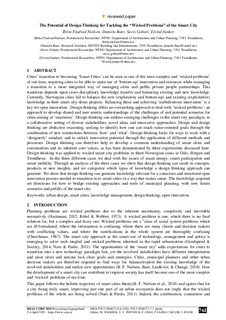| dc.contributor.author | Nielsen, Brita Fladvad | |
| dc.contributor.author | Baer, Daniela | |
| dc.contributor.author | Gohari, Savis | |
| dc.contributor.author | Junker, Eivind | |
| dc.date.accessioned | 2019-10-31T07:37:10Z | |
| dc.date.available | 2019-10-31T07:37:10Z | |
| dc.date.created | 2019-04-10T09:14:46Z | |
| dc.date.issued | 2019 | |
| dc.identifier.isbn | 978-3-9504173-7-1 | |
| dc.identifier.uri | http://hdl.handle.net/11250/2625493 | |
| dc.description.abstract | Cities’ transition to becoming ‘Smart Cities’ can be seen as one of the most complex and ‘wicked problems’ of our time; requiring cities to be able to make use of ‘bottom-up’ innovation and resources while managing a transition to a more integrated way of managing cities and public private people partnerships. This transition depends upon cross-disciplinary knowledge transfer and balancing existing and new knowledge. Currently, Norwegian cities fail to balance the new (exploratory and bottom-up) and existing (exploitative) knowledge in their smart city demo projects. Balancing these and achieving ‘ambidextrous innovation’ is a key for open innovation. Design thinking offers an overarching approach to deal with ‘wicked problems’; an approach to develop shared and user-centric understandings of the challenges of and potential scenarios for cities aiming at ‘smartness’. Design thinking can address emerging challenges in the smart city paradigm, in a collaborative setting of diverse stakeholders, novel ideas and innovative approaches. Design and design thinking are abductive reasoning, seeking to identify how one can reach value-oriented goals through the combination of new connections between ‘how’ and ‘what’. Design thinking looks for ways to work with a ‘designerly’ mindset, and to unlock innovation potential through the application of different methods and processes. Design thinking can therefore help to develop a common understanding of smart cities and communities and its inherent core values, as has been demonstrated by three experiments discussed here. Design thinking was applied to wicked smart city problems in three Norwegian cases in Oslo, Bergen and Trondheim. In the three different cases we deal with the issues of smart energy, smart participation and smart mobility. Through an analysis of the three cases we show that design thinking can result in concepts, products or new insights, and we categorize which types of knowledge a design thinking approach can generate. We show that design thinking can generate knowledge relevant for a conscious and structured open innovation process needed to transition in to smart cities in a way that makes sense. The knowledge acquired set directions for how to bridge existing approaches and tools of municipal planning, with new future scenarios and pitfalls of the smart city. | nb_NO |
| dc.language.iso | eng | nb_NO |
| dc.publisher | CORP – Competence Center of Urban and Regional Planning | nb_NO |
| dc.relation.ispartof | Proceedings of the 24th International Conference on Urban Planning, Regional Development and Information Society | |
| dc.relation.ispartof | Proceedings of the 24th International Conference on Urban Planning, Regional Development and Information Society | |
| dc.subject | Urban design | nb_NO |
| dc.subject | Smart cities | nb_NO |
| dc.subject | Knowledge management | nb_NO |
| dc.subject | Design thinking | nb_NO |
| dc.subject | Open innovation | nb_NO |
| dc.title | The Potential of Design Thinking for Tackling the “Wicked Problems” of the Smart City | nb_NO |
| dc.type | Chapter | nb_NO |
| dc.type | Conference object | nb_NO |
| dc.description.version | publishedVersion | nb_NO |
| dc.subject.nsi | VDP::Teknologi: 500 | nb_NO |
| dc.identifier.cristin | 1691269 | |
| dc.relation.project | Norges forskningsråd: 257660 | nb_NO |
| dc.relation.project | Norges forskningsråd: 255130 | nb_NO |
| cristin.unitcode | 7401,30,40,0 | |
| cristin.unitname | Arkitektur, byggematerialer og konstruksjoner | |
| cristin.ispublished | true | |
| cristin.fulltext | original | |
